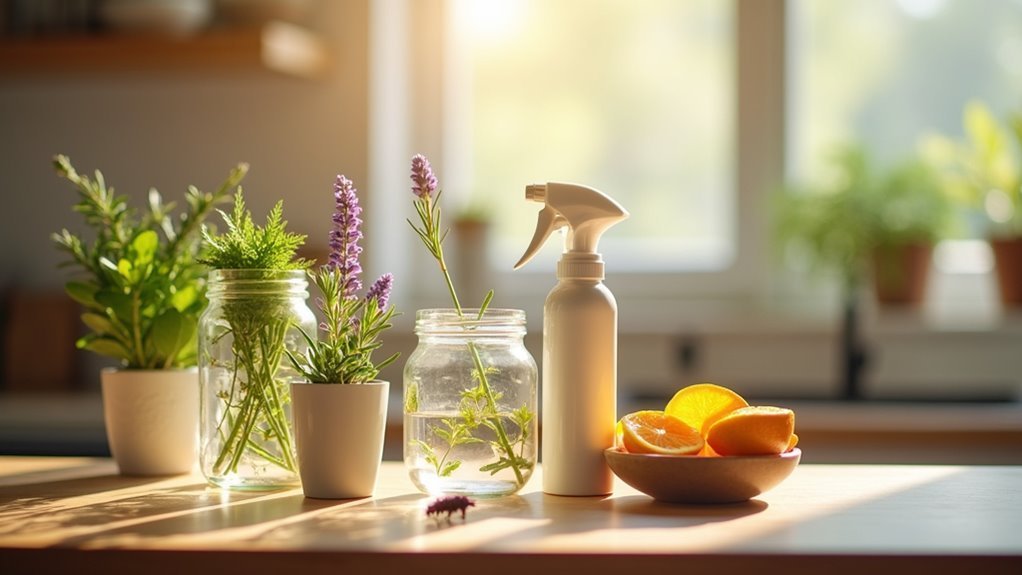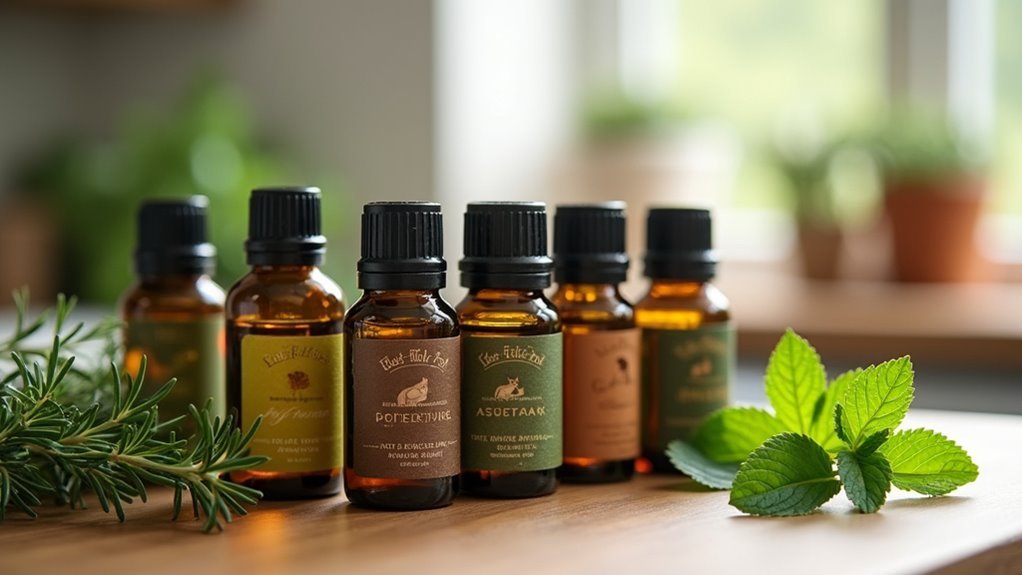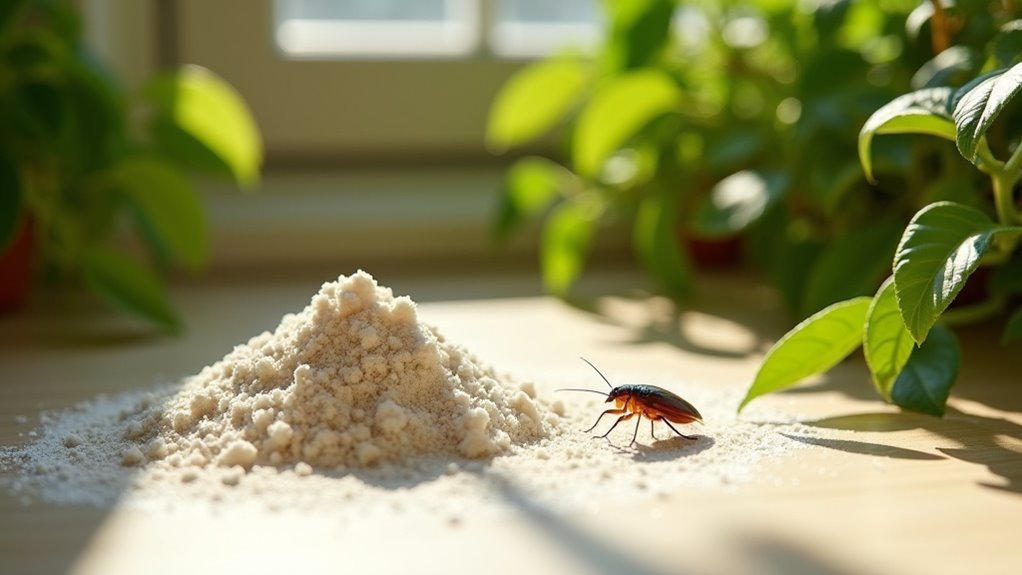You can protect your pets while eliminating cockroaches by using natural repellents like rosemary essential oil mixed with water (10-15 drops per 2 cups) or food-grade diatomaceous earth applied in cracks and crevices. These pet-safe alternatives avoid toxic chemicals that cause respiratory problems and neurological damage in animals. Coffee grounds and catnip also effectively deter roaches without harmful residues. Combine multiple methods with physical barriers like sealing cracks for enhanced protection that’ll give you thorough pest control strategies.
Why Natural Repellents Are Essential for Pet-Owning Households

The safety of your beloved pets should never be compromised when tackling a cockroach problem in your home. Natural repellents offer the perfect solution for pet-owning households, providing effective pest control without exposing your furry friends to toxic chemicals.
Unlike traditional insecticides that leave harmful residues, pet-friendly roach deterrents contain plant-based ingredients with minimal toxicity. These natural alternatives, such as rosemary oil, create a healthier living environment by reducing chemical exposure for both pets and humans.
Regular use helps maintain a pest-free home while lowering infestation risks that could trigger allergies or health issues in your pets. Many natural repellents also provide additional benefits like antioxidant properties, making them an intelligent choice for conscientious pet owners seeking effective, safe pest control solutions.
Understanding the Risks of Chemical Pesticides to Pets
When you reach for that conventional cockroach spray, you’re potentially exposing your pets to a cocktail of dangerous chemicals that can wreak havoc on their health.
Chemical pesticides contain toxic ingredients that cause respiratory problems, neurological damage, and severe gastrointestinal distress in pets. If your furry friends inhale these substances or lick contaminated surfaces, they’ll likely experience vomiting, diarrhea, drooling, tremors, and lethargy—symptoms requiring immediate veterinary care.
Chemical pesticides pose serious health risks to pets, causing respiratory issues, neurological damage, and gastrointestinal problems that demand immediate veterinary attention.
These harmful residues don’t disappear quickly, creating prolonged exposure risks throughout your home.
The EPA strongly recommends choosing pet safe alternatives over conventional pesticides. You can’t afford to gamble with your pet’s wellbeing when effective natural solutions exist that eliminate cockroaches without compromising your companion’s health and safety.
Essential Oils That Effectively Deter Cockroaches

You’ll find that rosemary oil serves as another powerful cockroach deterrent while remaining completely safe for your furry companions.
This aromatic herb contains compounds that cockroaches can’t tolerate, making it an excellent addition to your natural pest control arsenal.
However, you must dilute rosemary oil properly—typically mixing 10-15 drops with water in a spray bottle—to guarantee it’s effective without being overwhelming to your pets’ sensitive noses.
Rosemary Oil Benefits
Aromatic rosemary oil stands out as one of nature’s most effective cockroach deterrents, combining powerful pest-repelling properties with complete safety for your furry companions.
You’ll find that rosemary oil’s strong scent disrupts roaches’ sensory receptors, making your home less appealing to these unwanted invaders. Essential oils like rosemary offer additional benefits beyond pest control – they provide antioxidant properties and digestive support for dogs.
Creating your spray is simple: mix a few drops of rosemary oil per cup of water. This non-toxic solution allows targeted application in problem areas without leaving harmful residues.
You can spray confidently around pet areas, knowing you’re protecting both your family and animals. Users consistently report significant decreases in cockroach sightings when incorporating rosemary oil into their natural pest management strategy.
Proper Dilution Methods
Mastering the correct dilution ratios transforms essential oils into powerful cockroach deterrents while maintaining safety for your household.
You’ll need to mix 10-15 drops of your chosen essential oil with one cup of water in a spray bottle. This concentration creates an effective barrier against cockroaches without overwhelming your pets’ sensitive noses.
Before applying your diluted solution widely, test it on a small, hidden area first. This prevents potential damage to surfaces or fabrics.
Once you’ve confirmed it’s safe, spray the mixture in cockroach hiding spots like behind appliances, under sinks, and along baseboards.
Remember that proper dilution methods require consistent reapplication. Refresh your essential oil spray every few days or after cleaning to maintain its repelling effectiveness.
How to Create and Apply Essential Oil Spray Solutions
While store-bought sprays often contain harsh chemicals that can harm your pets, creating your own essential oil cockroach repellent offers a safer alternative that’s both effective and easy to make.
To prepare your essential oil spray, combine 10-15 drops of rosemary or peppermint oil with 2 cups of water in a spray bottle. Shake well before each application to distribute the oils evenly.
Mix 10-15 drops of rosemary or peppermint oil with 2 cups water in a spray bottle for instant pest control.
Target areas where cockroaches typically hide—cracks, crevices, and spaces behind appliances. Spray generously to repel roaches effectively.
Before widespread use, test the solution on a small, hidden surface to check for adverse reactions. Reapply every few days or after cleaning to maintain the spray’s repellent properties and keep your home cockroach-free naturally.
Diatomaceous Earth as a Natural Cockroach Deterrent

You’ll find diatomaceous earth to be one of the most effective natural cockroach deterrents that won’t harm your pets.
This powdery substance works by damaging cockroaches’ exoskeletons on contact, causing them to dehydrate and die within days.
We’ll explore how DE eliminates these pests and the proper techniques for applying it safely around your home and furry companions.
How Diatomaceous Earth Works
Diatomaceous earth consistently ranks among the most effective natural cockroach deterrents because of its unique physical properties and mechanical action against these persistent pests.
When cockroaches walk across this powder, the microscopic sharp edges damage their exoskeletons, creating tiny cuts that cause fatal dehydration within days. Unlike chemical pesticides, diatomaceous earth’s low toxicity makes it safer around your family and pets.
This mechanical killing method disrupts cockroach lifecycles rather than providing instant results. You’ll typically see effectiveness within one to three weeks as the population gradually decreases.
The fossilized diatom particles work continuously, making cockroaches avoid treated areas. For best results, you’ll need to apply diatomaceous earth in dry locations where cockroaches frequently travel, including cracks, crevices, and areas near food sources.
Safe Application Methods
Although diatomaceous earth offers excellent pet safety compared to chemical pesticides, proper application techniques guarantee maximum effectiveness while protecting your furry companions.
When applying this natural deterrent, you’ll want to focus on strategic placement while minimizing your pets’ exposure to treated areas.
Follow these essential application guidelines to confirm diatomaceous earth remains safe to use around your pets:
- Apply thin layers only in dry areas where cockroaches frequently travel
- Target cracks, crevices, and hidden spots where roaches congregate
- Temporarily restrict pet access to treated zones during initial application
- Avoid applying in areas where pets eat, drink, or sleep regularly
- Monitor for respiratory discomfort and ventilate spaces adequately
Expect visible results within 1-3 weeks as the powder gradually impacts the cockroach population through dehydration.
Proper Application Methods for Food-Grade Diatomaceous Earth
Three critical factors determine the success of food-grade diatomaceous earth as a cockroach repellent: proper placement, correct application technique, and environmental conditions.
You’ll want to target cracks and crevices where roaches travel, focusing on corners and baseboards in dry areas. Use a dust applicator or shaker to create thin, even layers without generating excessive powder clouds that could irritate your pets or family.
Keep your pets away from treated areas until the dust settles completely. Since moisture destroys diatomaceous earth’s effectiveness, you’ll need to reapply after cleaning or if areas become wet.
Check treated zones regularly for roach activity and refresh the powder as needed to maintain consistent population control throughout your home.
Boric Acid Safety Guidelines for Pet Owners
While boric acid offers effective cockroach control, you’ll need to exercise extreme caution when pets share your home.
Though generally low in toxicity when used properly, boric acid can cause serious health issues if your furry friends ingest large amounts or experience prolonged exposure.
Boric acid poses minimal risk when used correctly, but large ingestion or extended exposure can harm pets significantly.
To determine if boric acid is Safe to Use Around your pets, follow these essential safety measures:
- Apply boric acid only in areas completely inaccessible to pets, like behind appliances and inside wall voids.
- Store all boric acid powder in tightly sealed containers placed out of your pets’ reach.
- Use minimal amounts to reduce exposure risks and potential inhalation irritation.
- Monitor your pets for symptoms like vomiting or depression after application.
- Always follow manufacturer label instructions and safety guidelines precisely.
Coffee Grounds and Catnip as Natural Roach Repellents
You’ll find that coffee grounds create an effective barrier against cockroaches since their strong aroma naturally repels these pests from treated areas.
Catnip works even better as a deterrent because it contains nepetalactone, a compound that cockroaches actively avoid.
Both options give you powerful pest control without putting your pets at risk from toxic chemicals.
Coffee Grounds Repel Roaches
Since coffee grounds contain caffeine that’s toxic to cockroaches, they make an excellent natural repellent that’s completely safe for your pets.
The strong scent from coffee grounds masks food odors that typically attract roaches, creating an effective barrier around your home. When cockroaches ingest the caffeine, it disrupts their nervous systems and can prove fatal.
Here’s how you can use coffee grounds to repel cockroaches:
- Sprinkle used grounds around kitchen cabinets and countertops
- Place small bowls of grounds near entry points like doorways
- Apply grounds along baseboards where roaches commonly travel
- Refresh the grounds every few days to maintain potency
- Focus on areas with previous roach activity for maximum effectiveness
Catnip Natural Deterrent Properties
Another powerful natural repellent that’s completely safe for your furry friends is catnip, which contains nepetalactone—a compound that cockroaches absolutely can’t stand.
This natural oil creates an effective barrier against roach infestations without introducing harmful chemicals into your home environment. You can sprinkle dried catnip around entry points, cracks, and crevices where these pests typically travel.
Unlike toxic pesticides, catnip won’t harm your pets or family members while effectively deterring unwanted visitors. You’ll find this herb readily available at most garden centers or pet stores.
Studies show that applying catnip consistently leads to noticeable decreases in roach sightings within just a few days, making it an excellent non-toxic solution for pest control.
Creating Physical Barriers to Prevent Cockroach Entry
While chemical repellents can be effective, creating physical barriers offers the most reliable long-term solution for keeping cockroaches out of your home without risking your pets’ safety.
This safe pest control method focuses on prevention rather than elimination, making it ideal for households with furry family members.
Here’s how you’ll create effective physical barriers:
- Seal all cracks and crevices in walls, floors, and around windows and doors using caulk or weatherproof sealant
- Install door sweeps and weather stripping on exterior doors to block outdoor access points
- Cover vents and utility openings with fine mesh screens to prevent entry through overlooked pathways
- Inspect and repair plumbing leaks regularly to eliminate water sources and drainage entry points
- Maintain clutter-free spaces, especially in kitchens and storage areas, removing potential hiding spots
Maintaining a Clean Environment to Discourage Infestations
Beyond installing physical barriers, keeping your home spotless serves as your most powerful weapon against cockroach invasions.
Maintaining a clean environment eliminates the food and water sources these pests desperately need to survive.
You’ll want to sweep and vacuum regularly, removing food particles and debris that attract cockroaches. After meals, wipe down countertops and dining areas to eliminate potential food residues.
Don’t forget to seal garbage bins tightly and store pet food securely overnight.
Water sources require equal attention. Repair any leaks promptly and maintain dry environments by cleaning gutters regularly.
Conduct routine inspections for cracks and crevices around your home, sealing them immediately to reduce hiding spots.
These simple practices create an inhospitable environment that discourages cockroach infestations naturally.
Strategic Placement of Natural Repellents for Maximum Effectiveness
Once you’ve established a clean foundation, positioning your natural repellents strategically transforms them from simple deterrents into powerful pest control tools.
Strategic placement elevates natural repellents from basic deterrents to a comprehensive defense system against household pests.
Strategic placement focuses on intercepting roaches before they establish territory in your home.
Target these key areas for maximum impact:
- Entry points – Place rosemary oil diluted in water near doorways and windowsills to create protective barriers.
- Cracks and crevices – Use small containers or spray bottles to reach potential hiding spots where roaches shelter.
- High-traffic zones – Apply natural cockroach repellents where you’ve observed movement patterns or droppings.
- Dark corners – Focus on areas behind appliances, under sinks, and in pantries where pests typically gather.
- Refresh regularly – Reapply every few days to maintain potency and effectiveness.
Monitoring and Evaluating Natural Treatment Success
Effective natural cockroach control requires systematic monitoring to determine whether your pet-safe methods are actually working.
You’ll need concrete data to evaluate your treatment’s impact on roach populations.
Sticky glue traps serve as excellent monitoring tools, allowing you to observe roach activity and track repellent effectiveness over time.
Place them strategically near areas where you’ve applied natural treatments like rosemary oil or diatomaceous earth.
Keep a detailed log of roach sightings and trap captures to establish quantitative measurements.
Document frequency and locations weekly, then compare these numbers to pre-treatment levels.
Regular inspections of bait stations and treated areas reveal population changes.
Monitoring natural treatment success becomes clearer when you combine multiple approaches and consistently track results over several weeks or months.
Combining Multiple Natural Methods for Enhanced Protection
You’ll achieve better cockroach control by implementing layered defense strategies that combine multiple natural methods rather than relying on a single approach.
When you apply rosemary oil spray alongside food-grade diatomaceous earth, you’re creating overlapping barriers that address different aspects of cockroach behavior and biology.
Strategic synergistic application techniques, such as pairing essential oil blends with sticky traps and IGRs, maximize your pest control effectiveness while maintaining complete safety for your pets.
Layered Defense Strategies
While individual natural repellents can deter cockroaches, combining multiple methods creates a more robust defense system that’s still completely safe for your pets.
You’ll maximize effectiveness by implementing these layered strategies:
- Mix rosemary oil, vinegar, and baking soda to create a thorough barrier that targets different roach behaviors.
- Apply food-grade diatomaceous earth alongside essential oil sprays for immediate deterrence plus long-term desiccation effects.
- Vacuum regularly and clean all surfaces to eliminate food particles while applying natural repellents in strategic locations.
- Use sticky traps with your repellent routine to monitor roach activity and measure your success.
- Maintain consistent application for several weeks to disrupt their breeding cycle and force them to relocate.
This multi-pronged approach disrupts cockroaches’ habitat while keeping your furry family members completely safe.
Synergistic Application Techniques
When you strategically combine rosemary oil with food-grade diatomaceous earth, you’re creating a powerful one-two punch that addresses both immediate deterrence and long-term elimination. The rosemary oil repels cockroaches while diatomaceous earth dehydrates them upon contact.
| Method | Application | Synergy Partner |
|---|---|---|
| Rosemary oil + diatomaceous earth | Entry points, cracks | Vinegar surface spray |
| Essential oils barrier | Doorways, windows | Regular vacuuming |
| IGRs + natural repellents | Hidden areas | Food source removal |
| Peppermint oil perimeter | Base of walls | Tea tree oil spray |
| Vinegar cleaning solution | Countertops, floors | Diatomaceous earth dust |
You’ll maximize effectiveness by pairing essential oils with consistent cleaning routines. Apply IGRs in conjunction with barrier methods to disrupt reproduction while preventing new infestations from establishing.
When Natural Methods Require Professional Pest Control Support
Although natural cockroach repellents offer pet-safe solutions for minor infestations, they can’t always handle severe problems where cockroaches have established large colonies throughout your home.
When you’re dealing with overwhelming numbers, professional exterminators become necessary to regain control while maintaining pet safety.
- Rapid reproduction cycles make cockroaches difficult to eliminate with natural methods alone during heavy infestations.
- Professional exterminators can assess infestation severity and create targeted treatment plans that prioritize pet safety.
- Integrated pest management combines natural products with professional-grade solutions to minimize chemical exposure.
- Customized approaches allow exterminators to adjust their methods based on your specific pet situation.
- Combined strategies using both DIY natural methods and professional treatments often yield the most effective long-term results.
Frequently Asked Questions
How Do I Get Rid of Roaches Without Harming My Pet?
You’ll want to use pet-safe gel baits in inaccessible areas, food-grade diatomaceous earth where roaches travel, and natural repellents like diluted rosemary oil that won’t harm your furry friend.
What Is the Best Homemade Roach Repellent?
You’ll find equal parts water and vinegar works best as a homemade roach repellent. It disrupts their scent trails effectively, preventing them from returning to treated areas while remaining completely safe.
What Smell Keeps Roaches Away Naturally?
You’ll find that peppermint, eucalyptus, rosemary, lemon, and vinegar naturally repel roaches. These strong scents disrupt their sensory perception. You can use essential oils, citrus solutions, or vinegar mixtures around entry points effectively.
What Is the Best Roach Killer That Won’t Harm Pets?
You’ll find gel baits with indoxacarb work best since they’re placed where pets can’t reach them. Alternatively, food-grade diatomaceous earth effectively dehydrates roaches while remaining safe around your furry companions.
In Summary
You’ve learned effective pet-safe methods to repel cockroaches naturally without endangering your furry companions. By combining essential oils, diatomaceous earth, and strategic placement techniques, you’ll create a protective barrier that’s both powerful and safe. Remember to monitor your results consistently and don’t hesitate to adjust your approach. If infestations persist despite your natural efforts, you’ll know when it’s time to seek professional help while maintaining your pet’s safety.





Leave a Reply